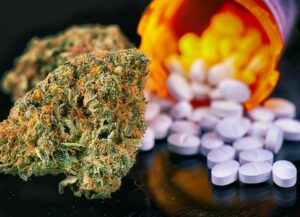Fentanyl is the new face of the American opioid crisis. This potent painkiller
is a synthetic opioid drug that’s up to 50 times stronger than heroin and 100 times more potent than morphine.
Fentanyl is now a contributing factor in nearly half of all overdose deaths nationwide, and it’s directly responsible for nearly a third of these deaths.
FOLLOW US ON FACEBOOK & INSTAGRAM
But according to some exciting research, cannabis could be a powerful tool to help reduce fentanyl addiction and overdose deaths.
What Is Fentanyl?
Fentanyl belongs to a class of drugs called opioids. This class also includes:
- Morphine
- Heroin
- Hydrocodone
- Oxycodone
Some opioids such as morphine and heroin are natural, derived directly from the opium poppy plant. But like other prescription opioid medications, fentanyl is a synthetic drug, created in the laboratory to be purer and stronger than its natural counterparts are. The idea was to create something to provide fast, consistent relief from many kinds of pain.
In this way, fentanyl is a “super opioid,” capable of delivering quicker, more powerful pain relief than other opioids, because it delivers a fast jolt to the brain’s network of opioid receptors.
Because fentanyl is so potent at such small quantities, doctors can legally prescribe it only to treat a specific kind of pain in people who have cancer. “Breakthrough” pain is sudden and severe pain that strikes cancer patients from time to time even if they’re already receiving regular doses of an opioid pain reliever. Fentanyl can act quickly alongside other medications to treat that kind of pain, but only under tightly controlled circumstances—and its use must be monitored closely.
Fentanyl’s prescribing information states that it shouldn’t be used to relieve short-term pain such as:
- A migraine headache
- Chronic pain from conditions like osteoarthritis
- Pain arising from injury
But doctors frequently prescribe it for these kinds of conditions, too. Addiction experts point out that this kind of off-label prescribing contributes considerably to the high rates of addiction and overdose associated with fentanyl.
Fentanyl has a long list of risks and side effects. These can include:
- Stomach distress and nausea
- Drowsiness
- Dizziness
- Confusion
- Abnormal thoughts
- Problems with coordination and balance
- Depressed or slow breathing
All opioids depress activity in the autonomic nervous system that’s responsible for regulating automatic functions such as heartbeat and respiration. But fentanyl is unique among opioids in that it specifically depresses respiration, not heart rate—and the wrong dose can stop a person’s breathing in less than a minute.
The risks of taking fentanyl increase if it’s taken along with a large group of other drugs that include:
- Commonly used antibiotics
- Antifungal medications
- Benzodiazepines for mood regulation
- A number of other drugs for conditions as varied as HIV, schizophrenia, nausea and insomnia
Using alcohol and street drugs while taking fentanyl also raises risks.
Fentanyl Creates a New Opioid Crisis
Fentanyl has been called the “third wave” of the ongoing opioid crisis.
The first wave came with the widespread overprescribing and overuse of prescription opioid drugs like oxycodone. When tighter regulations on pharmacies and physicians began to make these drugs harder to get, heroin use increased, creating the second wave.
Now, fentanyl is becoming increasingly popular as a way to get a fast, potent high—often in combination with heroin or other kinds of street drugs.
Fentanyl has made its way from doctors’ offices to the streets, and experts say this shift is fueling the spiraling rates of fentanyl addiction, overdoses and deaths. When prescription medications became too hard to get, consumers turned to heroin. And as heroin becomes less available and less appealing, more and more people are turning to fentanyl.
But the fentanyl that’s most easily available comes not from a doctor’s prescription, but from illegal sources. Most street fentanyl is made cheaply and quickly in China and then smuggled into the U.S. through Mexico and waterways on both coasts.
Illegal fentanyl can be an unknown quantity. It’s usually mixed with a wide variety of other drugs like oxycodone, heroin and cocaine. Adding too much of these other drugs can make the mixture far more potent than users expect. And like other opioids, fentanyl is highly addictive. All of these factors contribute to the high rates of fentanyl addiction and overdoses.
Cannabis Can Be a Safer Alternative to Opioids
Fentanyl and other opioids work by activating a network of receptors in the brain geared to respond specifically to opioids. These opioid receptors are found in the mesolimbic area of the brain. This area contains neural pathways that relate to:
- Pleasure
- Learning
- Pain signaling
Fentanyl can cross the blood brain barrier faster and trigger more intense responses in opioid receptors than other opioid medications can. But cannabis can also activate responses in the pathways for pleasure, reward and pain signaling.
Just as the body has a natural network of receptors that responds to opioids, it also has a system that responds to cannabinoids. The endocannabinoid system (ECS) is a rich network of receptors found in almost every part of the body. Cannabinoids produced naturally by the body as well as the very similar ones found in cannabis activate these receptors.
Cannabinoid receptors are also found alongside opioid receptors in the midbrain and mesolimbic area. This explains why cannabis can trigger pleasure and reward responses that are similar to the effects of opioids.
Cannabis can also affect pain signaling, so that it can provide effective relief for chronic pain from a number of different health conditions, just as opioids do.
Many cannabis consumers say that marijuana has helped them reduce their use of opioids, or even eliminate them entirely. And the research seems to say that along with activating ECS receptors in the brain’s pleasure-reward-learning pathways, cannabis can provide “synergistic analgesia.”
Synergistic analgesia means that when cannabis and an opioid like morphine or oxycodone combine for pain relief, this mixture can relieve pain more efficiently than either an opioid or cannabis alone. This allows people to use lower doses of opioids. It also reduces the risk of dependence and addiction on these kinds of medications.
ECS receptors are found throughout the body, but virtually no ECS receptors exist in the brainstem, which is where the autonomic nervous system lives. This means that cannabis can’t depress respiratory activity to harmful or fatal levels as fentanyl can. And while cannabis activates responses in the brain’s pleasure pathways, it doesn’t trigger the processes that create physical dependence and potentially life-threatening withdrawal symptoms.
Fentanyl works fast—and it can kill fast, too. Experts are struggling to find solutions for the fentanyl crisis. But research seems to confirm that cannabis may be the secret weapon that helps relieve pain and save lives.
Photo credit: nokturn/Shutterstock.com
If you’re new to cannabis and want to learn more, take a look at our Cannabis 101 index of articles. And if you have questions about cannabis, ask them and our community will answer.






